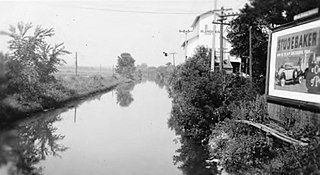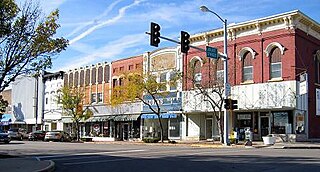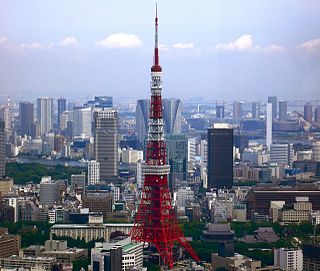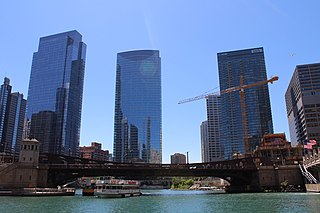Related Research Articles

William Butler Ogden was an American politician and railroad executive who served as the first Mayor of Chicago. He was referred to as "the Astor of Chicago." He was, at one time, the city's richest citizen. He brought the Galena & Chicago Union RR out of insolvency and was its first president in 1847. He created the Chicago & North Western Railway from the failed remains of the Chicago, St.Paul, Fond du Lac and was its first president in 1859. He spearheaded the 1st transcontinental railroad as the Union Pacific and was its first president in 1862 [although he relinquished that position due to health.]

The Chicago River is a system of rivers and canals with a combined length of 156 miles (251 km) that runs through the city of Chicago, including its center. Though not especially long, the river is notable because it is one of the reasons for Chicago's geographic importance: the related Chicago Portage is a link between the Great Lakes and the Mississippi River Basin, and ultimately the Gulf of Mexico.

The Illinois and Michigan Canal connected the Great Lakes to the Mississippi River and the Gulf of Mexico. In Illinois, it ran 96 miles (154 km) from the Chicago River in Bridgeport, Chicago to the Illinois River at LaSalle-Peru. The canal crossed the Chicago Portage, and helped establish Chicago as the transportation hub of the United States, before the railroad era. It was opened in 1848. Its function was partially replaced by the wider and deeper Chicago Sanitary and Ship Canal in 1900, and it ceased transportation operations with the completion of the Illinois Waterway in 1933.

The Illinois River is a principal tributary of the Mississippi River at approximately 273 miles (439 km) in length. Located in the U.S. state of Illinois, the river has a drainage basin of 28,756.6 square miles (74,479 km2). The Illinois River begins with the confluence of the Des Plaines and Kankakee rivers in the Chicago metropolitan area, and it generally flows to the southwest across Illinois, until it empties into the Mississippi near Grafton, Illinois. Its drainage basin extends into southeastern Wisconsin, northwestern Indiana, and a very small area of southwestern Michigan in addition to central Illinois. Along its shores are several river ports, including Peoria, Illinois. Historic and recreation areas on the river include Starved Rock, and the internationally important wetlands of the Emiquon Complex and Dixon Waterfowl Refuge.

Summit is a city in Cook County, Illinois, United States. The population was 11,161 at the 2020 census. The name Summit, in use since 1836, refers to the highest point on the Chicago Portage between the northeast-flowing Chicago River and the southwest-flowing Des Plaines River located just north of the city.

LaSalle or La Salle is a city in LaSalle County, Illinois, United States, located at the intersection of Interstates 39 and 80. It is part of the Ottawa, IL Micropolitan Statistical Area. Originally platted in 1837 over one square mile, the city's boundaries have grown to 12 sq mi (31 km2). Named in honor of 17th century Illinois valley explorer, the Sieur de La Salle, City boundaries extend from the Illinois River and Illinois and Michigan Canal to a mile north of Interstate 80 and from the city of Peru on the west to the village of North Utica on the east. Starved Rock State Park is located approximately 5 mi (8 km) to the east. The population was 9,582 as of the 2020 census, down from 9,609 at the 2010 census. LaSalle and its twin city, Peru, make up the core of the Illinois Valley. Due to their combined dominance of the zinc processing industry in the early 1900s, they were collectively nicknamed "Zinc City."

Pontiac is a city in and the county seat of Livingston County, Illinois, United States. The population was 11,150 in the 2020 Census. The 1984 movie Grandview, U.S.A. was set in Pontiac.

Hudson is a village in McLean County, Illinois, United States. The population was 1,753 at the 2020 census. It is part of the Bloomington–Normal Metropolitan Statistical Area.

Le Roy is a city in McLean County, Illinois, United States. The population was 3,512 at the 2020 census.

The Panic of 1837 was a financial crisis in the United States that began a major depression which lasted until the mid-1840s. Profits, prices, and wages dropped, westward expansion was stalled, unemployment rose, and pessimism abounded.

The Galena and Chicago Union Railroad (G&CU) was the first railroad constructed out of Chicago, intended to provide a shipping route between Chicago and the lead mines near Galena, Illinois. The railroad company was chartered on January 16, 1836, but financial difficulties delayed construction until 1848. While the main line never reached Galena, construction to Freeport, Illinois, allowed it to connect with the Illinois Central Railroad, thus providing an indirect route to Galena. A later route went to Clinton, Iowa.

The 2000s United States housing bubble or house price boom or 2000shousing cycle was a sharp run up and subsequent collapse of house asset prices affecting over half of the U.S. states. In many regions a real estate bubble, it was the impetus for the subprime mortgage crisis. Housing prices peaked in early 2006, started to decline in 2006 and 2007, and reached new lows in 2011. On December 30, 2008, the Case–Shiller home price index reported the largest price drop in its history. The credit crisis resulting from the bursting of the housing bubble is an important cause of the Great Recession in the United States.
A real-estate bubble or property bubble is a type of economic bubble that occurs periodically in local or global real estate markets, and it typically follows a land boom. A land boom is a rapid increase in the market price of real property such as housing until they reach unsustainable levels and then declines. This period, during the run-up to the crash, is also known as froth. The questions of whether real estate bubbles can be identified and prevented, and whether they have broader macroeconomic significance, are answered differently by schools of economic thought, as detailed below.

The Japanese asset price bubble was an economic bubble in Japan from 1986 to 1991 in which real estate and stock market prices were greatly inflated. In early 1992, this price bubble burst and Japan's economy stagnated. The bubble was characterized by rapid acceleration of asset prices and overheated economic activity, as well as an uncontrolled money supply and credit expansion. More specifically, over-confidence and speculation regarding asset and stock prices were closely associated with excessive monetary easing policy at the time. Through the creation of economic policies that cultivated the marketability of assets, eased the access to credit, and encouraged speculation, the Japanese government started a prolonged and exacerbated Japanese asset price bubble.

The Chicago Portage was an ancient portage that connected the Great Lakes waterway system with the Mississippi River system. Connecting these two great water trails meant comparatively easy access from the mouth of the St. Lawrence River on the Atlantic Ocean to the Rocky Mountains, and the Gulf of Mexico. The approximately six-mile link had been used by Native Americans for thousands of years during the Pre-Columbian era for travel and trade.

The first real estate bubble in Florida was primarily caused by the economic prosperity of the 1920s coupled with a lack of knowledge about storm frequency and the poor building standards.
Wilcox v. Jackson, 38 U.S. 498 (1839), sometimes nicknamed the "Beaubien Land Case" was a legal action decided by the United States Supreme Court concerning the land under Fort Dearborn shortly after incorporation of Chicago as a town in Cook County, Illinois.

The 2005 Chinese property bubble was a real estate bubble in residential and commercial real estate in China. The New York Times reported that the bubble started to deflate in 2011, while observing increased complaints that members of the middle class were unable to afford homes in large cities. The deflation of the property bubble is seen as one of the primary causes for China's declining economic growth in 2013.

Wolf Point is the location at the confluence of the North, South and Main Branches of the Chicago River in the present day Near North Side, Loop, and Near West Side community areas of Chicago. This fork in the river is historically important in the development of early Chicago. Located about 1.6 miles (2.6 km) from Lake Michigan, this was the location of Chicago's first three taverns, its first hotel, Sauganash Hotel, its first ferry, its first drug store, its first church, its first theater company, and the first bridges across the Chicago River. The name is said to possibly derive from a Native American Chief whose name translated to wolf, but alternate theories exist.
The Alabama real estate bubble of the 1810s was a real estate bubble centered on Huntsville, caused by increasing cotton prices resulting from demand from English textile manufacturers, relatively high cotton yields in Alabama, as well as general speculation. In 1817, property in Madison County sold for around $2 per acre, while in 1818 it sold for $7.40 per acre on average, with some tracts reportedly sold "at prices ranging from $20 to $78 per acre," at a time when land on the American frontier was sold for $2 per acre. By 1819, acreage prices plummeted to around $0.20 per acre due to the Panic of 1819 and increasing global supply of cotton.
References
- ↑ Will, George F., "National Transportation Debate in a Nutshell: Infrastructure Is Economic Destiny." The Philadelphia Inquirer. Available at .
- ↑ "1897—Chicago Street Name Origins". chicagology.com. Retrieved April 6, 2024.
- 1 2 Hoyt, Homer. 1933. One Hundred Years of Land Values in Chicago. Chicago: The University of Chicago Press.
- 1 2 3 4 Glaeser, Edward L., A Nation of Gamblers: Real Estate Speculation and American History (working paper). Retrieved April 7, 2013 from http://www.hks.harvard.edu/var/ezp_site/storage/fckeditor/file/pdfs/centers-programs/centers/taubman/working_papers/Glaeser_Ely.pdf.
- 1 2 Walters, William D. 2010. Selling Location: Illinois Town Advertisements, 1835–1837. Department of Geography-Geology, Illinois State University. Available at http://geo.illinoisstate.edu/downloads/walters_towns.pdf.
- ↑ "Betting the house". The Economist. ISSN 0013-0613 . Retrieved July 10, 2024.